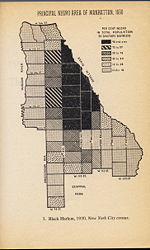| wiki | search |
Main Page | Groups and Assignments | Bios | History | Harlem | Diversity Today | Help
Before there was a Black Harlem and prior to the 1860s New York City's black population formed small, segregated communities that never exceeded 8% of any ward’s population. In 1800 two-thirds of the city’s black population lived in the area bound by Canal Street in the North and Cedar Street in the south. From the 1820s to the 1840s the black population started shifting to the northwest and a small group of blacks moved to Greenwich Village. During the 1860s the black population moved further north and 55.2% of the people lived below Houston Street. By the 1870s 41.5% of the people lived below Houston street while a greater number lived above Houston, 17.3% between Houston and Fourteenth street and 36% between Fourteenth and Eighty-six street. The movement continued and by 1890 almost 80% of the city’s black population lived above Fourteenth street and 62% of it lived between Fourteenth and Eighty-sixth streets. By 1900 65.5% of the black population lived between Fourteenth and Eighty-sixth streets and the proportion of the black population above Eighty-sixth street rose from 4.8% in 1870 to 24.3% in 1900. In the first decade of 1900 San Juan Hill became the largest black neighborhood in the city. However past this point Harlem started becoming the largest black neighborhood in the city and by 1920 70% of Manhattan’s black population lived in Harlem.
The black population of Brooklyn followed similar patterns. In the 1860s about 84% of the black population in Brooklyn lived in either the Borough Hall-Fort Greene Park section, which held 53.3% of the people, or in southern part of Williamsburg and northern part of Stuyvesant Heights, which held 30.7% of the people. By 1870 the black community in Borough Hall-Fort Greene Park had extended to Crown Heights and the western region of Bedford Stuyvesant and then held 57.3% of the black population. The community in the Williamsburg area started leaving by the 1870s and moved through Stuyvesant Heights to the northern area part of Bedford-Stuyvesant which then held 13.4% of Brooklyn's black population. In 1890 there were two black communities in Brooklyn one in Stuyvesant Heights and the other to the east of the Borough Hall-Fort Greene Park community which now included community in Bedford-Stuyvesant. During the 1890s there was a continuing movement of blacks to Crown Heights and Bedford-Stuyvesant. Past this point it becomes difficult to accurately discern black population's living trends due to a change in the method of census reporting.
(Source: Seth M. Scheiner, Negro Mecca. NYU Press, 1965)
To Learn More
- A New York Times journalist explores San Juan Hill:
[|The Rise and Fall of San Juan Hill (video)] [Cradle for Serious Grooving (Article)]

